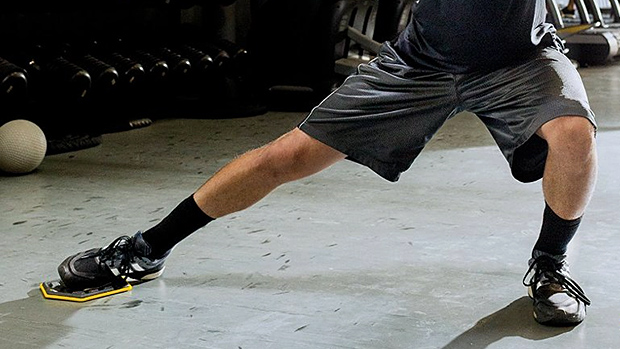I love books written by the iron-game pioneers. For every newly-released book I read, I read at least one or two that are decades old. It's fascinating to discover where many of today's training concepts originated and reaffirm that there truly is nothing new under the sun.
As an example, consider the apparently novel one-day arm routines that you see periodically in muscle magazines. Iron legend Harry Barton Paschall wrote about this "unique form of rest-pause training" that was practiced by Peary Rader, the founder of Iron Man magazine, ages ago. It's not a new method by any means.
Paschall exposed many of these original concepts. A professional cartoonist by trade, he served as a longtime contributor to Bob Hoffman's Strength and Health magazine and authored several classic training books.
Case in point, Paschall's first book, Muscle Moulding, was published in 1950 and is considered one of the best bodybuilding books ever written. In fact, this book inspired one of the most effective training programs that I've ever designed.
Below is the first weight-gaining routine from that book, and the one that stimulated some creative thinking on my part. See if it has the same effect on you:
- Seated curl: 10 reps
- Seated press: 10 reps
- Squat: 20 reps
- Bent-arm pullover: 15 reps
- Squat: 20 reps
- Bench press: 10 reps
- Squat: 20 reps
- Straight-arm pullover: 15 reps
Notice the frequency and sequencing of squats – they appear three times in the workout, while every other exercise appears only once or twice. There's good reason for that. Besides the deadlift, no other "non-Olympic" weight lifting movement stimulates as much muscle mass as the squat, and no other movement gives you as much in return for your training effort.
This is why old time bodybuilders like three-time Mr. Olympia Sergio Oliva said squats made the whole body grow. "If you want big arms, start squatting," was a favorite Oliva quote, and when "The Myth" talked about big arms, people listened.
The emphasis on squats wasn't just for building size. "You're only as strong as your legs," was Paschall's motto, who also felt that "Most people do not give their legs enough work to do."
Performing multiple sets of squats will give your legs plenty of attention, but certainly performance will suffer if each set is taken to the limit, especially if straight sets are conducted.
But what if you sequenced squats after an upper body movement, or better yet after two upper body movements, in a circuit fashion similar to the weight-gaining routine above? In theory, that should help improve recovery and performance – and I can tell you from experience that it works!
Most people associate circuit training with muscular endurance and fat loss, but it can also be a powerful hypertrophy protocol if performed correctly. And with the size comes some serious strength.
All right, let's get to it. Here are some effective programs that use the concepts discussed above. Pick the program that suits your training level and give it an honest shot. I think you'll be quite impressed with the results.
This is a three-program beginner progression. Each program lasts four weeks and workouts are conducted three times a week on nonconsecutive days (e.g., Monday, Wednesday, and Friday).
Program 1 (first 4 weeks)
| Exercise | Sets | Reps | Tempo | Rest | |
|---|---|---|---|---|---|
| A1 | Reverse-grip cable pulldown | 1 | 15-20 | 2-0-1-0 | 60 sec. |
| A2 | Seated neutral-grip dumbbell press | 1 | 15-20 | 2-0-1-0 | 60 sec. |
| A3 | Squat | 1 | 15-20 | 2-0-1-0 | 60 sec. |
| A4 | One-arm dumbbell row | 1 | 15-20 | 2-0-1-0 | 60 sec. |
| A5 | Flat neutral-grip dumbbell press | 1 | 15-20 | 2-0-1-0 | 60 sec. |
| A6 | Squat | 1 | 15-20 | 2-0-1-0 | 60 sec. |
| A7 | Standing reverse-grip EZ-bar curl | 1 | 15-20 | 2-0-1-0 | 60 sec. |
| A8 | Decline dumbbell triceps extension | 1 | 15-20 | 2-0-1-0 | 60 sec. |
| A9 | Squat | 1 | 15-20 | 2-0-1-0 | 60 sec. |
| A10 | Seated dumbbell wrist curl | 1 | 15-20 | 2-0-1-0 | 60 sec. |
| A11 | Seated reverse-grip dumbbell wrist curl | 1 | 15-20 | 2-0-1-0 | 60 sec. |
| A12 | Squat | 1 | 15-20 | 2-0-1-0 | 60 sec. |
Program 2 (weeks 5 through 8)
| Exercise | Sets | Reps | Tempo | Rest | |
|---|---|---|---|---|---|
| A1 | Wide-grip cable pulldown | 2 | 12-15 | 3-0-1-0 | 75 sec. |
| A2 | Seated Arnold press | 2 | 12-15 | 3-0-1-0 | 75 sec. |
| A3 | Squat | 2 | 12-15 | 3-0-1-0 | 75 sec. |
| A4 | Seated cable row | 2 | 12-15 | 3-0-1-0 | 75 sec. |
| A5 | Close-grip bench press | 2 | 12-15 | 3-0-1-0 | 75 sec. |
| A6 | Squat | 2 | 12-15 | 3-0-1-0 | 75 sec. |
| A7 | Seated dumbbell curl | 2 | 12-15 | 3-0-1-0 | 75 sec. |
| A8 | Flat EZ-bar triceps extension | 2 | 12-15 | 3-0-1-0 | 75 sec. |
| A9 | Squat | 2 | 12-15 | 3-0-1-0 | 75 sec. |
Program 3 (weeks 9 through 12)
| Exercise | Sets | Reps | Tempo | Rest | |
|---|---|---|---|---|---|
| A1 | Mid-grip chin-up | 3 | 10-12 | 4-0-1-0 | 90 sec. |
| A2 | Incline neutral-grip dumbbell press | 3 | 10-12 | 4-0-1-0 | 90 sec. |
| A3 | Squat | 3 | 10-12 | 4-0-1-0 | 90 sec. |
| A4 | Incline hammer curl | 3 | 10-12 | 4-0-1-0 | 90 sec. |
| A5 | Parallel-bar dip | 3 | 10-12 | 4-0-1-0 | 90 sec. |
| A6 | Squat | 3 | 10-12 | 4-0-1-0 | 90 sec. |
Feel free to use different squat variations in each program. For instance, wide-stance back squat (Program 1), heel-elevated back squat (Program 2), and conventional back squat (Program 3).

For intermediate and advanced trainees, a two-day routine works best. Each workout is conducted twice a week (e.g., Day 1 on Monday and Thursday, and Day 2 on Tuesday and Friday) for a maximum of six exposures. After 3 weeks, switch to a new routine.
You can follow Program 1 with Program 2 if you like, or vice versa. However, a more effective option is to insert a bodypart split routine between them.
Program 1
Day 1
| Exercise | Sets | Reps | Tempo | Rest | |
|---|---|---|---|---|---|
| A1 | Lean-away pull-up | 3-4 | 6-8 | 4-0-X-0 | 90 sec. |
| A2 | Incline pronated-grip dumbbell press | 3-4 | 6-8 | 4-0-X-0 | 90 sec. |
| A3 | Front squat | 3-4 | 6-8 | 4-0-X-0 | 90 sec. |
| A4 | Incline dumbbell curl | 3-4 | 6-8 | 4-0-X-0 | 90 sec. |
| A5 | Parallel-bar dip | 3-4 | 6-8 | 4-0-X-0 | 90 sec. |
| A6 | Front squat | 3-4 | 6-8 | 4-0-X-0 | 90 sec. |
Day 2
| Exercise | Sets | Reps | Tempo | Rest | |
|---|---|---|---|---|---|
| A1 | Bench press | 3-4 | 6-8 | 4-0-X-0 | 90 sec. |
| A2 | Seated cable row | 3-4 | 6-8 | 4-0-X-0 | 90 sec. |
| A3 | Trap-bar deadlift | 3-4 | 6-8 | 4-0-X-0 | 90 sec. |
| A4 | Low-pulley rope French press | 3-4 | 6-8 | 4-0-X-0 | 90 sec. |
| A5 | Seated preacher EZ-bar curl | 3-4 | 6-8 | 4-0-X-0 | 90 sec. |
| A6 | Trap-bar deadlift | 3-4 | 6-8 | 4-0-X-0 | 90 sec. |
Program 2
Day 1
| Exercise | Sets | Reps | Tempo | Rest | |
|---|---|---|---|---|---|
| A1 | Close-neutral-grip chin-up | 3-4 | 8-10 | 3-0-X-0 | 90 sec. |
| A2 | Seated neutral-grip dumbbell press | 3-4 | 8-10 | 3-0-X-0 | 90 sec. |
| A3 | Back squat | 3-4 | 8-10 | 3-0-X-0 | 90 sec. |
| A4 | Seated Zottman curl | 3-4 | 8-10 | 3-0-X-0 | 90 sec. |
| A5 | Tiger-bend push-up | 3-4 | 8-10 | 3-0-X-0 | 90 sec. |
| A6 | Back squat | 3-4 | 8-10 | 3-0-X-0 | 90 sec. |
Day 2
| Exercise | Sets | Reps | Tempo | Rest | |
|---|---|---|---|---|---|
| A1 | Flat neutral-grip dumbbell press | 3-4 | 8-10 | 3-0-X-0 | 90 sec. |
| A2 | One-arm dumbbell row | 3-4 | 8-10 | 3-0-X-0 | 90 sec. |
| A3 | Bent-knee deadlift | 3-4 | 8-10 | 3-0-X-0 | 90 sec. |
| A4 | Standing low-pulley curl | 3-4 | 8-10 | 3-0-X-0 | 90 sec. |
| A5 | Lying EZ-bar triceps extension | 3-4 | 8-10 | 3-0-X-0 | 90 sec. |
| A6 | Bent-knee deadlift | 3-4 | 8-10 | 3-0-X-0 | 90 sec. |
In this scheme, squats are performed on one day and deadlifts on the other. No screwing around with lower quality leg movements – just the big boys! Paschall suggested that "doing some functional, vigorous exercise without overdoing the non-essential accessory exercises" may be the key to breaking out of a rut and putting on some true muscle growth. I completely agree.
In Super Squats, author Randall Strossen says using short inter-repetition rest intervals to squeeze 20 reps out of a 10RM load is a potent stimulus for hypertrophy and strength, but you can only get one set out with that approach. It won't work if you plan to perform multiple sets. It's a good idea on this routine to keep a couple reps in reserve, at least initially. Do not train to failure at first.
And why even perform multiple sets? Paschall noted that enthusiasts who experimented with 2, 3 and sometimes 6 or 8 sets of squats on an abbreviated program "grew like weeds in a garden."
Again, I agree. If you take a look at the intermediate/advanced routines above, you end up performing a total of 6 or 8 sets of squats or deadlifts in each workout. It's quite deceptive because of the way they're sequenced, but it adds up.
As good as these programs may appear to be on your screen, there are two real-life issues that must be addressed: busy gyms and lack of equipment.
First, don't even attempt this routine in a busy gym. If you schedule your workouts during peak hours, I guarantee that someone is going to mess up your plans, which could result in a confrontation and possibly even an assault charge when you toss the hapless rube into the juice bar.
Try to train during non-peak hours or consider a private facility if possible, and there's no better place than home – which brings us to the second matter of adequate equipment.
The above programs are specifically designed with home gyms in mind – only basic equipment is used, and no piece of equipment is used twice in a workout.
For example, a squat and bench press on the same day would be a real pain in the ass if you only had one Olympic barbell. This program takes this real-life limitation into account. Feel free to substitute exercises where necessary, just keep this in mind.
The typical low-intensity, machine-based circuit training being propagated in certain gym franchises produces inferior results, but that isn't an indictment of all circuit training. Go back in time and try this old school bad boy.
It isn't easy, but it's simple and gets the job done. And sometimes that's all you need.





